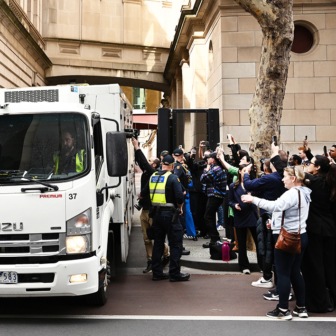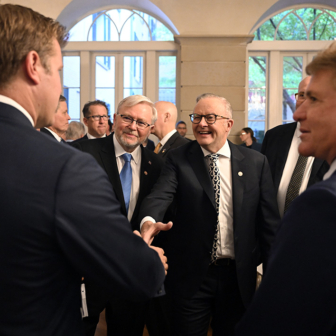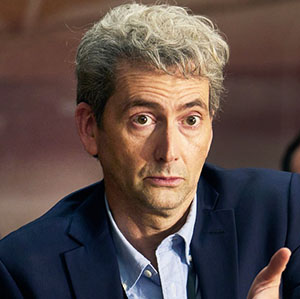Tim Colebatch died in Canberra on 21 January. One of Australia’s leading political and economic journalists, he wrote more than 160 pieces for Inside Story after leaving the Age in 2013. Here his deputy at the Age and successor as economics editor, Peter Martin, pays tribute to Tim’s work and what he showed us about the way journalism should be done.
I was about to start working with Tim Colebatch. We’d been working alongside each other — but for different organisations — for some time. He would give me tips on things he had found by digging into statistics or government reports that he thought readers of the Canberra Times, my paper, should know about — things he couldn’t fit into the Age.
I would reward him, or acknowledge him, with words like this:
Someone much better than me at pulling out figures from such reports has used a pen and paper to work out where the ACT overspends compared to the rest of Australia and where it under-taxes.
And that was the point: Tim could do with a piece of paper and a pen what I, and most other people, couldn’t do.
Anyway, I was about to move from one office in the press gallery to another to work with him as his deputy. I happened to be speaking to Melbourne economist Nick Gruen, who told me that Tim Colebatch was extraordinary. Nick said he had read something Tim had written, based on data no one else knew about, and asked Tim where he had got them from. Tim had sent him the figures — pages and pages of photocopied calculations done by hand. Tim had dug into several different documents (before the age of spreadsheets), copied out masses of figures by hand and combined them to discover something that wasn’t at all apparent from any of the individual documents. It must have taken hours. Nick said he had a vision of Tim’s wife (Mary) watching the television while Tim did sheet after sheet, calculation after calculation, without complaint.
When I got to the Age, I discovered that Tim did it all the time.
Peter, I know you’re doing the jobs figures today. I’ve just pulled out the six-month trend growth for each state, set it alongside the previous six months and this is what it shows…
Tim’s figuring produced a much greater insight than the Australian Bureau of Statistics press release or summary itself, which almost everyone else was content with.
It was not only journalists and those of us who worked with Tim who noticed this. When he died, an ABS official who had dealt with him wrote that:
Most journos develop stories by cutting-pasting from media releases. Tim was a whip-sharp user of economic data who actually read statistical publications to develop his own take on the situation.
Another wrote:
As a public servant often required to provide background on the how of policies or programs to journalists, I can vouch for how genuine was Tim Colebatch. No journalist approached an inquiry with more open-mindedness, understood the issues more deeply, nor cared more.
Tim’s method — open-minded methodical inquiry — gave us truths that no one else had discovered.
In 2011 when high inflation figures came out and all manner of highly credentialed journalists began writing that there was a breakout and that inflation would stay high, Tim looked inside the figures and saw that almost all the underlying pressure was ebbing away, even though the official measures of underlying inflation didn’t say so. Tim wrote this, explaining why, was not thanked by his highly credentialed competitors, and was right. Soon after, inflation dived to a new lower plane and didn’t return to where it had been, until Covid.
All through 2011 the employment numbers seemed suspiciously flat. The usual growth was missing, making it look as if the economy was off the boil. Through a tip-off at a conference, Tim had learnt that it wasn’t employment that was behaving strangely, it was the way the ABS calculated its figures. The Bureau multiplies the number of people it surveys by whatever number it needs to in order to represent the Australian population.
But the Bureau’s estimates of the Australian population had been wrong, and it had been slowly winding down the multiplication factor each month throughout 2011, which made it look as if employment hadn’t been growing, even though it was. The contact at the conference would have found it hard to explain to anyone else what had happened. I didn’t think Tim would be able to explain it in the Age. I suggested he hold off until we could finesse it. He said no, he would write it then and there, which he did in perfectly clear English, helping change people’s understanding of where the economy was heading.
For readers, Tim made his writing look simple, easy, obvious, and obviously right, even though to produce it he had had to do some very complicated figuring — the kind of things few other people could do. And he gave what he wrote moral force. He would make the reader feel that anger was justified, that something was egregiously wrong even though it hadn’t seemed egregiously wrong until Tim had uncovered it.
In most years until the Howard government halved the headline rate of capital gains tax in 1999, more landlords made money than lost it: landlords as a group made money renting out properties, which is how it should be. After Howard’s change, landlords as a group lost money, every single year. Landlords became losers, overwhelmingly deliberate losers, in order to negatively gear and sell their properties later for a capital gain that would be barely taxed.
Of course landlords dived into the market pushing owner-occupiers out of the way. Of course this pushed up prices. Of course this meant that Australians who would once have been owner-occupiers had to make do with renting from the same people who had pushed buying out of their reach. Of course it was wrong. Tim made you feel outraged with him, even about things he would not have been outraged about until he had uncovered the data.
In a piece for Inside Story in 2017 entitled “Yes, There Is Such a Thing as Too Much Immigration,” Tim presented findings that affronted him, partly because he wished they weren’t true. He said that in net terms an extra 474,000 people had found full-time jobs over the previous eight years. But only 74,000 of the jobs went to people born in Australia. The official figures had been “ignored by analysts” (which is probably because they, like me, wouldn’t have known where to find them).
“I am unambiguously pro-immigration,” Colebatch wrote, “but if the level and nature of the immigration are not working for us, I suggest we turn down the tap.” That wasn’t a conclusion Tim had wanted to come to, but it derived from the data, the only source of truth.
One night (we worked late more often than not) I asked him what kind of reporting he liked best. Was it political reporting? Was it what the government was planning? He said it was statistics. Because they were the truth: the pure truth rather than being in part the product of spin or in part an account of who had said what.
Which isn’t to say Tim didn’t like politics. His reporting on electorates, polls and political trends was unmatched. And it was a resource for other reporters. Tim understood each Victorian seat, the distribution of preferences in each seat, how counting would develop, what a change of boundaries would do, and the way in which each Senate count would evolve over a fortnight.
Writing in Inside Story last April he raised the possibility that Anthony Albanese might turn out to have led Australia’s last majority Labor government. We won’t know for some time whether that turns out to be correct, but we can know, right now, that it was a possibility that presented itself to Tim after a careful and deep dive into everything electoral.
Remarkably, Tim didn’t think that what he did was extraordinary. Never in his writing did he suggest it was, and nor did he talk down to the reader. He took the reader (and fellow journalists) with him on a journey and made it seem obvious.
Australia Day wasn’t a thing back in 1971, but Tim joined the Age on 25 January, the eve of Australia Day, as one of five cadets, the only one who was a graduate. Mark Baker, who joined with him that day, said he wasn’t like the others:
We were juveniles, bemused, in awe of Tim. Bespectacled, he carried books in a stylish cloth shoulder bag and was always reading. While we were working out how to type with two fingers, Tim was writing serious analysis pieces on Bangladesh.
Tim quickly gravitated to writing analysis, and then editorials, but editorials grounded in data, writing lightly but not once-over lightly. And some of his editorials were masterpieces. One, prepared as a summer holder, examined official Tasmanian reports about plans for flooding the Franklin River. When it was published, while Tim was overseas, it turned the Franklin into an issue on the mainland. Victorians were talking about it.
Tim took on the environment round and kept reporting on the plans to destroy the river. He reported from the Franklin during the 1983 election campaign, explaining how the Commonwealth could stop the damming, which it did.
Some of Tim’s colleagues have told me he was a contrarian. But he wasn’t. He wanted to know the truth wherever it took him. One colleague from near the beginning, Tony Walker, put it better. He said that what defined Tim was his outsider’s perspective. This made Tim, he said, “not a typical product of Melbourne Grammar.” He was prepared to find out and analyse, rather than regurgitate his prejudices.
Although Tim must have started out with some prejudices. He told me that before he started reporting from Melbourne’s parliament house, he’d assumed that the Labor members of parliament must have been pretty good, representing the interests of the workers. Then he saw them.
Someone else reporting Victorian politics at that time was Frank McGuire, who worked in parliament house for the Melbourne Herald while Tim worked for the Age, and who later became a member of Victoria’s parliament. He told me that Tim set the standard for factually accurate, evidence-based, insightful analysis. While it has always been important, these days it’s rare.
In his obituary for the Age, Tim’s long-term colleague Damien Murphy paints him as something of a time capsule, carrying with him the ethos of the time when quality journalism, centred around the Age, took off:
Many of the journalists of the 1960s and 1970s took its ethos and went on to become huge influences in print, television and radio across Australia: They included Mike Willesee, Jennifer Byrne and Neil Mitchell. Eight edited metropolitan daily newspapers. Others chose literature, the law and politics. Some returned. But only one member of that generation remained on staff in a direct unbroken link to the era.
At a time when so much of modern political reporting became transactional — “I’ll report this in return for you telling me that” — Tim wouldn’t do it. In Canberra, the treasurer’s staff would hand me information in return for what they hoped would be good publicity. They never tried it with Tim.
Not that Tim wouldn’t engage with them. At press conferences, he would call them out. When treasurer Wayne Swan presented a graph that Tim thought was dodgy, Tim simply stood up and said so, and why. I remember thinking at the time that no one else in the room would have had the courage — and the confidence in their own judgement — to do that. From few other people would the treasurer have meekly accepted it.
Tony Walker had a word for this quality of Tim’s — “unyielding.” Tim wouldn’t say something unless he was sure it was right, and then he wouldn’t retreat for the sake of maintaining relationships. Michelle Grattan, his long-time Canberra colleague, put it this way: he constructed his own journalistic framework and operated within it, rather than running with the pack.
More than many other people, journalists (including myself) are needy. We thrive on praise. I’ve never known Tim to seek it out, and when we worked together I rarely offered it, although I figured he knew how extraordinary I thought he was. Afterwards, when he retired, and later as his days were becoming numbered, I told him every time we met.
It was the same in the office — he hated noise, he hated interruptions, he hated messiness. There are those who say Tim’s corner of the Age office in parliament house was messy. They are wrong. It was piled high with papers and ABS reports, but it was extremely neat. Tim knew where every single document was and could find it instantly.
In the office he ran the beer fridge and used it to send money to children he supported. Two of his keenest interests were India and Indonesia, where he wanted to go as a correspondent but never did. He did go to Washington, in the Reagan years, and was earlier tapped for a post, China correspondent, which he turned down because, legend has it, he had just been made president of the North Melbourne tennis club.
He reported on tennis for the Age and Inside Story. He loved tennis, he played tennis well, he was a ball boy at what’s now the Australian Open, and he met his wife Mary at the tennis.
And he loved Melbourne. This is important, and was important for Tim’s decades of work in Canberra. He had a mental social and electoral map of Melbourne. He knew how people felt in Melbourne, in different parts of Melbourne, and he could write about it with more understanding and moral force than people who hadn’t left.
His meticulously researched biography of Victorian premier Dick Hamer, whom Tim dubbed the liberal Liberal, owed everything to Tim’s deep understanding of Melbourne and also to Tim’s total respect for the truth.
In 2022, in the early days of his treatment, Tim wrote a review of another biography of a Victorian leader — Sumeyya Ilanbey’s biography of Dan Andrews. Tim said she depicted Andrews as someone who decided issues on political grounds and treated “their merits as secondary.” For Tim, there was no greater transgression.
I remember getting ready to leave the office one night. Tim was still there, working with sheets and sheets of paper and doing sums with a pen.
“What are you doing, Tim?” I asked.
“I am looking at British temperature records from the 1800s,” he told me. “I am trying to get a handle on the extent to which there has been global warming.”
“Tim, no one else would do that,” I said. “Everyone else uses secondary sources.”
“Shhh! Don’t tell,” he replied, and I left him to go on checking.
In October last year, Tim and I caught up at our local cafe, as we had done regularly for years. He told me the antivirals seemed to be holding back his cancer, but he didn’t think that would last.
And then he apologised. He had been up into the early hours of the morning attending a virtual press conference held by the International Energy Agency in Paris to outline its update on the path to limiting global warming to 1.5°C. He had interrogated the officials online, and he told me he still thought that if a lot of things fell into place we might just keep global warming to 1.5°C.
And then he walked home to write the piece. He concluded it by saying the Albanese government was
in danger of overpromising on targets while underdelivering on policies to achieve them. Its carbon price is limited to 200-odd companies, it is walking both sides of the street on fossil fuels, and most of the reviews it has launched have yet to produce outcomes. This is what happens when you allow the political staff to take charge of policy.
It was his last message to readers of Inside Story. •




